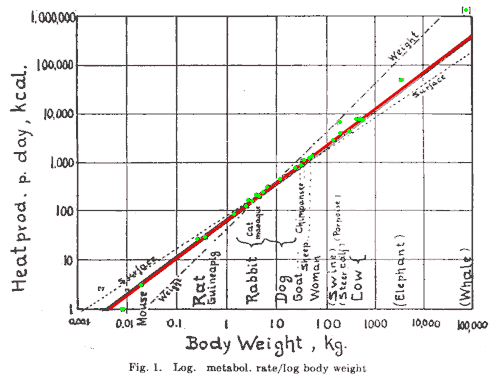An unexpected result
So, what did scientists actually find when they went out to measure the parameter "b"? How does body size scale with metabolism? The most famous early paper was published by Max Kleiber in 1947 and showed a surprising result. Body size seemed to scale with metabolism to the 3/4 power, rather than the 2/3 that was expected! This 3/4 power law became known as Kleiber's law. Here is his original graph:

Notice that the data are displayed on a log-scaled graph (of course!). The green points are the data, and they overlie the red line, which shows the 3/4 scaling relationship. The dotted line labeled "surface" indicates the line with a slope of 2/3 and the dash-dot line labeled "weight" indicates the slope if b = 1 (in other words, if the relationship were linear). These data are for mammals only, but further investigation found that this relationship was consistent for several groups over an unbelievable 21 orders of magnitude (from single-celled organisms all the way to elephants).

This 3/4 scaling pattern caused a great deal of confusion. What process was governing this strange result? Scientists struggled with it for years, and it wasn't until 1997 that a credible model was proposed.
Copyright University of Maryland, 2007
You may link to this site for educational purposes.
Please do not copy without permission
requests/questions/feedback email: mathbench@umd.edu